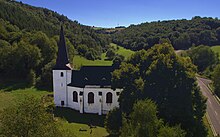Walholzkirche
The Walholzkirche is located in the district of Weiperath on the road to Hunolstein .
history
The church was built as a presumably wooden church between 1130 and 1150. The exact year of construction is not known. It was built in honor of the apostle Matthias , probably as a result of the apostle's rapidly growing veneration after his remains were found in Trier in 1127 . Before the Hunolstein Church was built in 1907, the Walholzkirche was the Catholic parish church for the surrounding communities. In a tax list ( Taxa generalis ) from 1330, Walholz is listed as a parish (next to Berhaben , Thalfang and Bischofsdhron ). Walholz-Morscheid also names the Taxa generalis from 1389 as a parish, which has since been separated from Berlicht. A visitation protocol from 1569 lists Walholz as the main parish church, while Morscheid with the church of St. Cuno and Gutenthal are named as subsidiary churches of Walholz.
After the destruction of Hunolstein Castle and the surrounding villages during the Thirty Years' War , the church lost its importance and the ecclesiastical center shifted to Morscheid. The parish was orphaned from around 1650 to 1803 and was cared for by the clergy from Morscheid. From 1756 a chaplain from Morscheid took care of the faithful. In 1803 the parish Walholz was formed with the parishes of Hunolstein, Weiperath and Odert. The current building was erected in 1760 as a conversion and extension of the dilapidated predecessor church. In addition, more church space was needed than the older church had to offer. The bell with the year 1392 and the tower, two thirds of which are from the 12th century in the lower part, have been preserved from the older church. Other witnesses at that time are a document of 1228 and the minutes of the Country Chapter Piesport from 1468. At that time Walholz branch of the large parish Berglicht , which included the following towns with their mills: Elzerath , Gräfendhron , Gutenthal, Hague , Horath , Hoxel, Lampersberg ( the later Hunolstein), Merschbach , Morscheid , Odert, Riedenburg, Weiperath and Wolzburg. The church is associated with Burg Hunolstein whose men the places mentioned loans of hearing and tributaries were.
A slight earthquake on July 19, 1846 created a crack in the length of the vault, which led to a risk of collapse. In 1907 the church was abandoned because of the new church in Hunolstein. The Holy Mass is rarely held here today. Since 1990 the church has been renovated with private donations, personal contributions and the commitment of the population.
Architectural styles
The church in hall construction with a three-sided choir closure is an old cultural monument and combines three architectural styles: the Romanesque former choir tower dates from the 13th century, and the nave in Gothic style from the 14th century. In the 18th century the church underwent a baroque redesign. It is surrounded by a churchyard with a wall, next to the church is an old, mighty linden tree. The church is a plastered quarry stone building, its tower is attached to the east. The interior of the church is 18.50 m long, 8.90 m wide and has a height of 4.30 to the fighter . The vault-free basement of the tower housed the sacristy . The bell sound leaves the bell chamber through three sound openings, over which an eight-sided helmet is enthroned. A round arched door leads to the choir, as well as the church has a round arched door on the west side. The three-bay nave has round-arched cross vaults without pillars .
source
- Information boards at the church
Coordinates: 49 ° 47 '53.8 " N , 7 ° 3' 30.4" E






